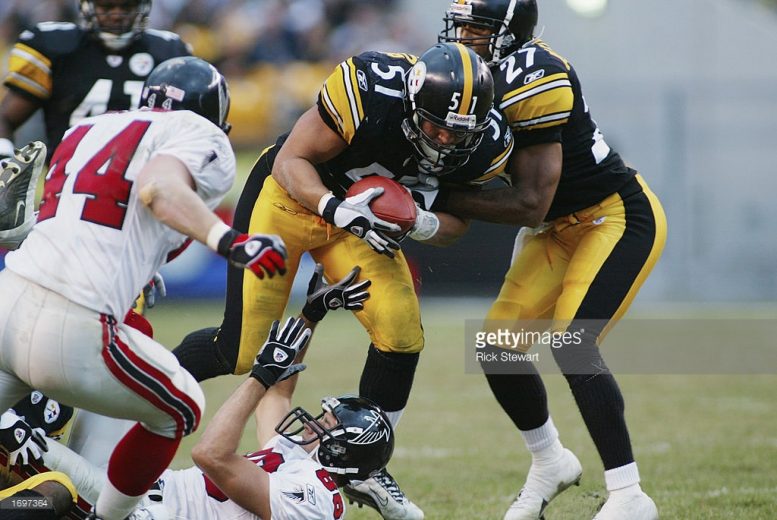For nearly a decade, James Farrior was an absolute linchpin in the middle of the vaunted Pittsburgh Steelers’ defense, leading the black and gold to two Super Bowl wins, cementing his status as one of the best linebackers in franchise history, even if he won’t have his bust enshrined in Canton.
Farrior, who played and started in 154 career games with the Steelers, finished his nine-year career in Pittsburgh with 1,085 tackles, 82 tackles for loss, 30.0 sacks, eight interceptions, 53 passes defensed, 12 force fumbles, 10 fumble recoveries and 47 quarterback hits. The numbers are absolutely eye-popping for a guy many didn’t know about until then Steelers’ Director of Football Operations Kevin Colbert signed off the street in free agency for just three years and $5.4 million.
That dominance he displayed in the heart of the Steelers’ defense ultimately led to his induction into the Steelers’ Hall of Honor in 2020. On Wednesday during a Steelers Time Machine episode with Stan Savran on Steelers.com, Farrior touched on many topics about his time with the Steelers, including James Harrison’s pick-six in Super Bowl XLIII and Santonio Holmes’ catch, as well as the rivalry against the Baltimore Ravens, and just how great of a teammate Joey Porter was.
However, Farrior did touch on an interesting topic early in the episode with Savran, talking about how he was able to find success so quickly in Pittsburgh.
Prior to signing with the Steelers, Farrior, who was originally drafted by the New York Jets with the eighth overall selection in the first round of the 1997 NFL Draft out of Virginia. During his four seasons with the Jets, Farrior was often misused as an outside linebacker, which stunted his growth and saw the Jets fail to get as much production out of him as they’d hoped for spending a top 10 pick on him. However, Farrior was 27 years of age and coming off of a final season with the Jets that included him registering 142 total tackles, 2 interceptions and 3 forced fumbles.
“I enjoyed my time there; it was a great learning experience for me,” Farrior said, according to video via Steelers.com. “Overall though, I don’t think I played as well as I should have. Things didn’t work out at the end quite as I thought it would, and I became a free agent. Pittsburgh was one of the teams that showed the most interest, and that’s how I ended up in Pittsburgh.
“To tell you the truth, they [Pittsburgh] the first team that offered me a contract,” Farrior added. “They were pretty much the only team that had money on the table to offer me to come play, and I felt like that was enough motivation for me to get the deal done.”
That certainly worked out in the Steelers’ favor as Farrior came in, shifted to inside linebacker in the Steelers’ 3-4 and ultimately developed into a two-time Pro Bowl linebacker and a two-time All-Pro under defensive coordinator Dick LeBeau, becoming that sideline-to-sideline linebacker that brought physicality and leadership to the position.
That subtle shift from an on-ball linebacker to off-ball going from New York to Pittsburgh ultimately unlocked the dominant player Farrior became in Pittsburgh.
“I feel that I played my best football when I was inside,” Farrior said. “I played outside linebacker on the line of scrimmage my first year with the Jets, and it was a position I was uncomfortable with and not used to, and it took me a lot of learning and adjustments to make. I think that had a little bit to do with my success on the field.
“Once I moved to inside, I felt like I was a better player when I could see what was going on and react from that, instead of just having to be right now (snaps fingers),” Farrior added. “I think moving back a little bit and giving me time to process things helped me out a lot. …I feel like having me in space and having me off the ball helped me out tremendously.”
Though he had a very good final season with the Jets, Farrior immediately took off in Pittsburgh in the Steelers’ 3-4 defense, recording 141 tackles in his second season before then finishing runner-up to Baltimore’s Ed Reed in 2004 for the NFL’s Defensive Player of the Year, at the same time earning his first Pro Bowl nod and his first All-Pro selection.
Ater a dominant 2004 season, Farrior went on to record 100+ tackles in six of his final eight seasons in Pittsburgh, quietly placing him among the greats at the position in Steelers’ lore.








